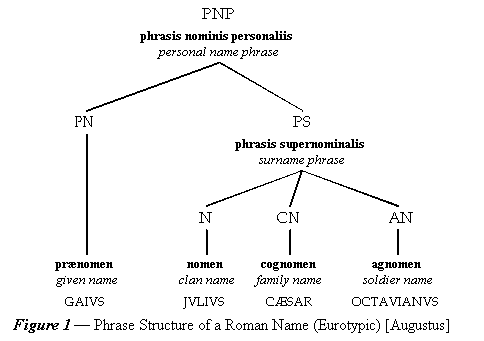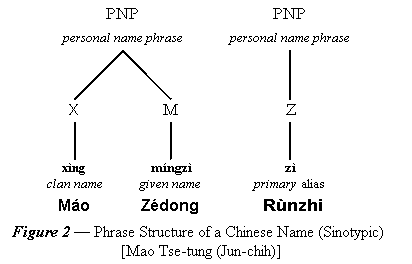
3.2 Phrase structure. The tokenizer and parser assign each name piece a category as given in the lexical entry for that name piece. The category is what is represented in the PS-RULES by a terminal symbol. Each possible morpheme or morpheme combination has an entry as a name in the LEXICON. The category tells how the name should be used for indexing and ordering. The rules tell us three things about the name structure. First, they tell about the constituency of the name structure. This means that the name phrase is composed of smaller phrases and ultimately of name pieces. Second, they specify the presence or absence of the various constituent elements. Third, they tell us about the usual ordering of the elements.
As an illustration consider examples of personal names from different cultures of the world. The phrase structure rules for names of Roman citizens would have ended in three or four categories. The full name consisted of 1) the given name (praenomen), 2) the clan name (nomen), 3) the family name (cognomen), and sometimes 4) a soldier name (agnomen). The nomen, cognomen, and agnomen would all be ordered parts of a surname phrase constituent. For most of his life the Emperor Augustus had the name Gaius Julius Caesar Octavianus. It wasn’t until a few years before he died that he carried the epithet “Augustus.” An alternate name like this is what is called an alias.

The Chinese also have a clan name (姓). Certain clans have a kind of name that is attached to the given name (名字) — a generational name (班次). This name is shared by all the siblings and first cousins (all the children of a man’s sons). Special care is taken not to repeat given names, so distinguishing kinds of alias are acquired or assigned as one’s circle of influence or popularity expands: courtesy names (字), pseudonyms (號 or 号), burial names (諡號), and temple names (廟號). There were also periods of time for each of the emperors of China called their “reign name” for use on the calendar.

Many cultures of the world assign only a single name to each individual. In these cases better identification of the individual makes the specification of culture (tribe, ethnic group, language) imperative. It is often the case that monotypic names have a translation equivalent (an alias), i.e., interpretation in the English language, which interpretation has the structure of a noun phrase in that language.

The Akan culture of Ghana (Fante and Ewe languages) assigns multiple names to each individual; some epithets later in life. Here we give the interpretation in English for convenience (Stewart, 1993). The name that becomes a surname to the western world may be an internal family distinguisher, as in figure 4, or some other descriptors. Individuals often have a Christian name as well as their native name. A number of inherited surnames have also become quite common.

